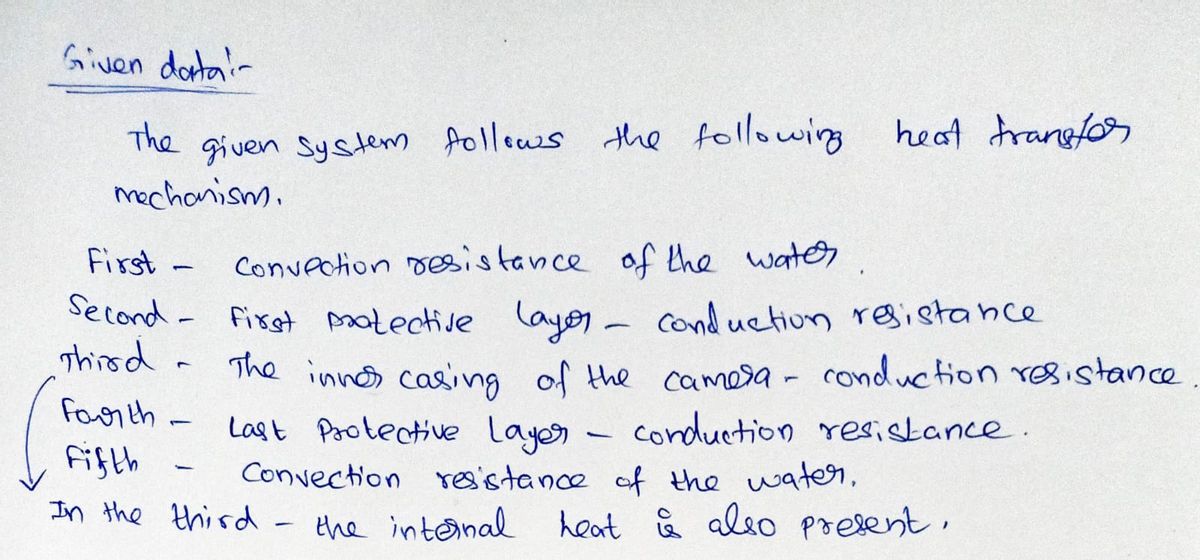A camera used for monitoring marine life is placed in water where T_ -5°C and the convection heat transfer coefficient h=1420 W/m²K. The camera is operating, but its battery is experiencing thermal runaway, causing the camera to become very hot, and there is volumetric heat generation, ġe inside it. There is no heat generation within the waterproof, protective enclosure surrounding it. The camera is already compromised; however, its owner hopes to save the protective case. Each interface (between layers A and B and between layers B and C) must not exceed a temperature of 185°C, or these plastic, protective layers will begin to melt. Approximate the camera and its casing as a composite, rectangular object with flat surfaces. The device's total thickness, L=LA + 2Lg +Lc. is much smaller than its area (into the page); therefore, 1-D conduction can be approximated through the layers. On the left surface of layer A, the temperature is measured to be T₁ = 8.0°C, and the temperature on the right-hand side of layer C is TR = 10.5°C. The central layer, B, is the camera. Assume uniform volumetric heat generation within this layer. Approximate the situation as steady-state. Neglect radiation and contact resistance. Furthermore, for any numerical answers, type in the numerical number only. Do not type in units.
A camera used for monitoring marine life is placed in water where T_ -5°C and the convection heat transfer coefficient h=1420 W/m²K. The camera is operating, but its battery is experiencing thermal runaway, causing the camera to become very hot, and there is volumetric heat generation, ġe inside it. There is no heat generation within the waterproof, protective enclosure surrounding it. The camera is already compromised; however, its owner hopes to save the protective case. Each interface (between layers A and B and between layers B and C) must not exceed a temperature of 185°C, or these plastic, protective layers will begin to melt. Approximate the camera and its casing as a composite, rectangular object with flat surfaces. The device's total thickness, L=LA + 2Lg +Lc. is much smaller than its area (into the page); therefore, 1-D conduction can be approximated through the layers. On the left surface of layer A, the temperature is measured to be T₁ = 8.0°C, and the temperature on the right-hand side of layer C is TR = 10.5°C. The central layer, B, is the camera. Assume uniform volumetric heat generation within this layer. Approximate the situation as steady-state. Neglect radiation and contact resistance. Furthermore, for any numerical answers, type in the numerical number only. Do not type in units.
Elements Of Electromagnetics
7th Edition
ISBN:9780190698614
Author:Sadiku, Matthew N. O.
Publisher:Sadiku, Matthew N. O.
ChapterMA: Math Assessment
Section: Chapter Questions
Problem 1.1MA
Related questions
Question

Transcribed Image Text:What is the thermal circuit for this entire system, including convection resistances?
T₂
T₂
T.
R=1/hA Rond-LA
TL
wwww.www
TL
Roy=1/hA Rond=L/K₂A
T₂
R₁
= 1/hA
T₁
wwwwwww
Roy=1/h
T₂
9₁
TL
T₁
Rond-L
Roud-LA
T₁
91
QBVB
T₁
91
T₂
Tavg
QBVB
TR
www.
d₂V₂
B
Round Lok
92
Rood LA
m
Road Lok
www mmmmmm
??
Roy-1/hA Rod=L/KA
T₂
TR
92
Tx
92
Road = LIKA
Reed Leke
R-1/hA
www
R₂
Kony = 1/hA
TR
R=1/h4
TR
ROOKE
T₂
T₂
R-1/h
T₂
= 1/hA

Transcribed Image Text:A camera used for monitoring marine life is placed in water where T.. -5°C and the
convection heat transfer coefficient h=1420 W/m²K. The camera is operating, but
its battery is experiencing thermal runaway, causing the camera to become very hot,
and there is volumetric heat generation, qe inside it. There is no heat generation
within the waterproof, protective enclosure surrounding it.
00:08
The camera is already compromised; however, its owner hopes to save the protective
case. Each interface (between layers A and B and between layers B and C) must not
exceed a temperature of 185°C, or these plastic, protective layers will begin to melt.
Approximate the camera and its casing as a composite, rectangular object with flat
surfaces. The device's total thickness, L=LA + 2LB +Lc, is much smaller than its area
(into the page); therefore, 1-D conduction can be approximated through the layers.
On the left surface of layer A, the temperature is measured to be T₁ = 8.0°C, and the
temperature on the right-hand side of layer C is TR-10.5°C. The central layer, B, is
the camera. Assume uniform volumetric heat generation within this layer.
Approximate the situation as steady-state. Neglect radiation and contact resistance.
Furthermore, for any numerical answers, type in the numerical number only. Do not
type in units.
h, T
111
water
T₂
A
protective
layer
B
qв
camera
2Lg
T₂
с
protective
layer
*
TR
h, T
111
LA - 20 mm
LB-10 mm
Lc-10 mm
ka=0.5 W/m*K
kB = 3 W/m*K
kc-0.5 W/m*K
Expert Solution
Step 1

Step by step
Solved in 2 steps with 2 images

Knowledge Booster
Learn more about
Need a deep-dive on the concept behind this application? Look no further. Learn more about this topic, mechanical-engineering and related others by exploring similar questions and additional content below.Recommended textbooks for you

Elements Of Electromagnetics
Mechanical Engineering
ISBN:
9780190698614
Author:
Sadiku, Matthew N. O.
Publisher:
Oxford University Press

Mechanics of Materials (10th Edition)
Mechanical Engineering
ISBN:
9780134319650
Author:
Russell C. Hibbeler
Publisher:
PEARSON

Thermodynamics: An Engineering Approach
Mechanical Engineering
ISBN:
9781259822674
Author:
Yunus A. Cengel Dr., Michael A. Boles
Publisher:
McGraw-Hill Education

Elements Of Electromagnetics
Mechanical Engineering
ISBN:
9780190698614
Author:
Sadiku, Matthew N. O.
Publisher:
Oxford University Press

Mechanics of Materials (10th Edition)
Mechanical Engineering
ISBN:
9780134319650
Author:
Russell C. Hibbeler
Publisher:
PEARSON

Thermodynamics: An Engineering Approach
Mechanical Engineering
ISBN:
9781259822674
Author:
Yunus A. Cengel Dr., Michael A. Boles
Publisher:
McGraw-Hill Education

Control Systems Engineering
Mechanical Engineering
ISBN:
9781118170519
Author:
Norman S. Nise
Publisher:
WILEY

Mechanics of Materials (MindTap Course List)
Mechanical Engineering
ISBN:
9781337093347
Author:
Barry J. Goodno, James M. Gere
Publisher:
Cengage Learning

Engineering Mechanics: Statics
Mechanical Engineering
ISBN:
9781118807330
Author:
James L. Meriam, L. G. Kraige, J. N. Bolton
Publisher:
WILEY